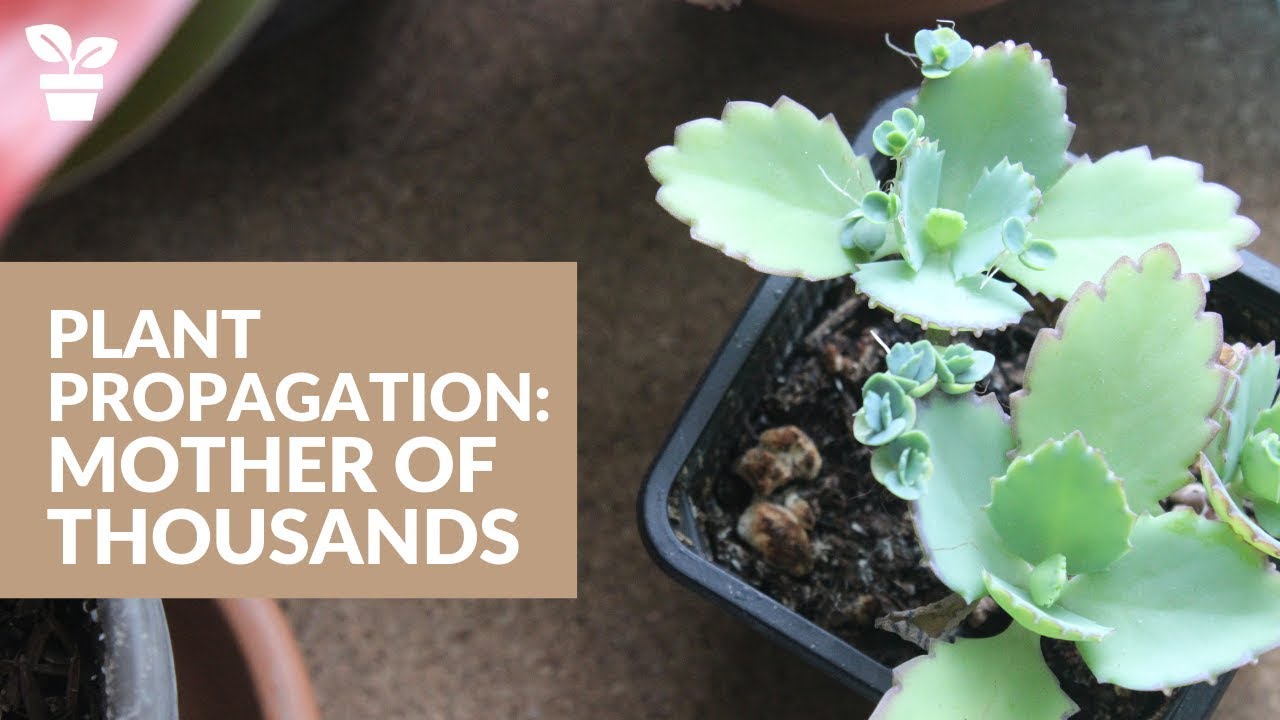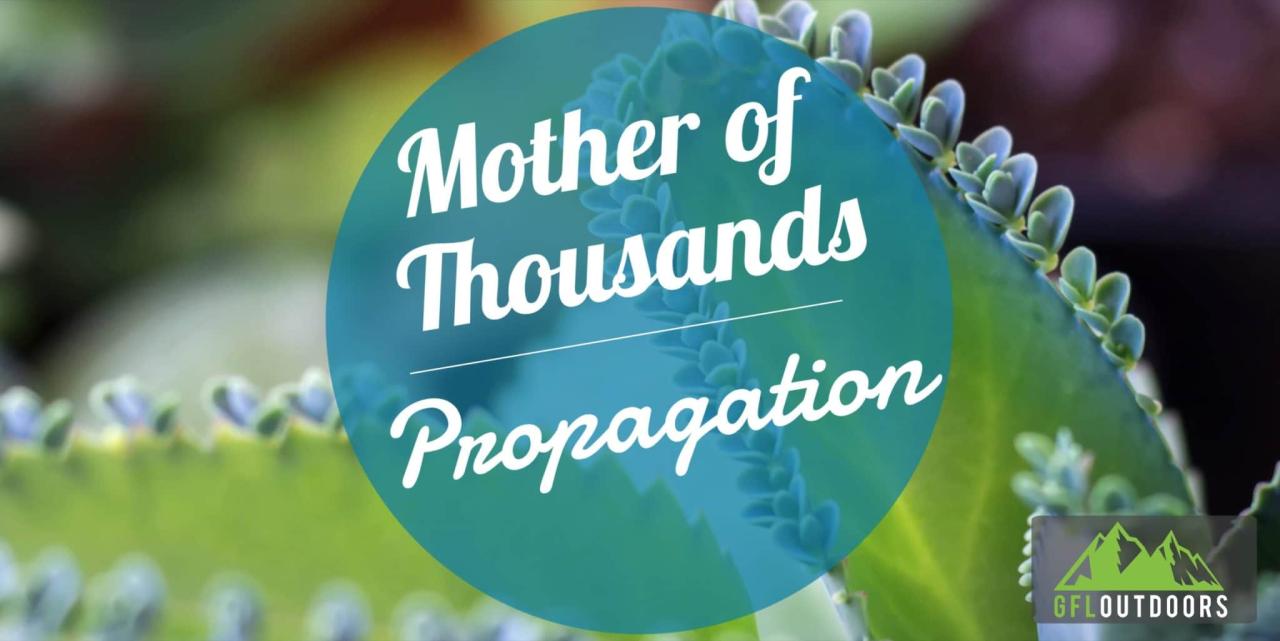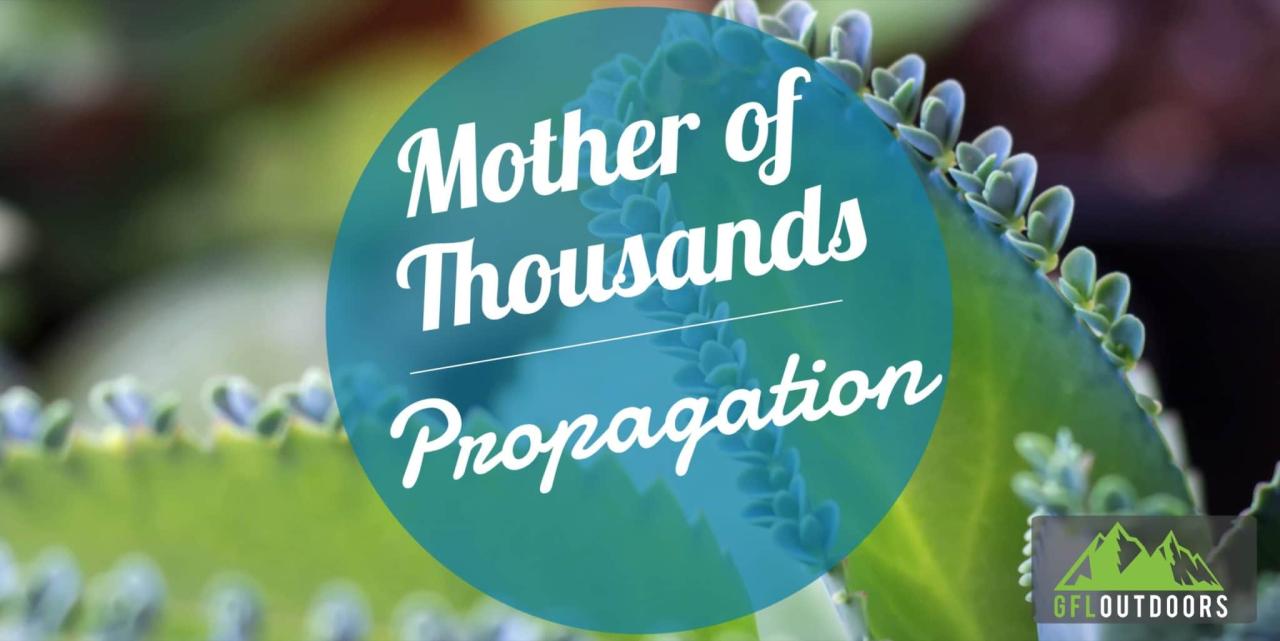How to Create a Thriving Garden with Mother of Thousands Propagation: Embark on a journey of verdant beauty with this resilient and prolific plant. Mother of Thousands, with its unique ability to reproduce prolifically, offers a captivating path to a flourishing garden.
This guide delves into the fascinating world of this plant, from its origins and propagation methods to its care, design applications, and troubleshooting tips. Discover the secrets to cultivating a thriving garden teeming with Mother of Thousands.
Known for its distinctive ability to produce plantlets on its leaves, Mother of Thousands (scientifically known as -Kalanchoe daigremontiana*) is a succulent native to Madagascar. This captivating plant thrives in warm climates and well-draining soil, making it a perfect addition to container gardens or as a ground cover in arid regions.
Introduction to Mother of Thousands
The Mother of Thousands plant, a captivating succulent known for its unique propagation method, is a popular choice for gardeners seeking an easy-to-care-for and visually appealing addition to their collections. This plant, belonging to the Crassulaceae family, is renowned for its prolific nature, with its ability to produce numerous plantlets along the edges of its leaves, contributing to its common name.
Scientific Name and Common Names
The Mother of Thousands plant is scientifically known as
-Kalanchoe daigremontiana*. It is also referred to by various other common names, including
* Mother of Thousands
- Bryophyllum daigremontianum
- Mexican Hat Plant
- Devil’s Backbone
These names reflect the plant’s characteristics, such as its abundant plantlet production, the distinctive shape of its leaves, and the spiny appearance of its stems.
Origin and Growing Conditions
The Mother of Thousands plant is native to Madagascar, an island nation off the southeastern coast of Africa. It thrives in warm, dry environments, similar to its natural habitat.The plant prefers well-drained soil and ample sunlight. However, it can tolerate partial shade, especially in hot climates.
It is essential to ensure proper drainage to prevent root rot, which can occur in overly moist conditions.
Propagation Methods
Mother of Thousands ( Kalanchoe daigremontiana) is a succulent that can be easily propagated using various methods. This allows you to create new plants from existing ones, expanding your garden or sharing with friends.
Methods of Propagation
Mother of Thousands can be propagated through several methods, each with its own advantages and disadvantages. The most common methods are:
- Leaf Cuttings: This method involves taking a healthy leaf from the plant and placing it on moist soil. The leaf will eventually produce plantlets along its edges, which can then be separated and grown independently.
- Plantlets: These are tiny, fully formed plantlets that grow along the edges of the Mother of Thousands leaves. They can be carefully removed and planted directly into soil, where they will quickly develop roots and grow into new plants.
- Stem Cuttings: A portion of the stem, including a few leaves, can be cut and placed in water or soil. The stem will develop roots and eventually grow into a new plant.
- Seeds: While less common, Mother of Thousands can also be propagated from seeds. These can be collected from the plant’s flowers and sown in a seed tray or pot. However, this method is less reliable than the other methods mentioned above.
Advantages and Disadvantages of Each Method
Each propagation method offers unique advantages and disadvantages:
Method |
Advantages |
Disadvantages |
Difficulty Level |
|---|---|---|---|
Leaf Cuttings |
Simple, reliable, produces multiple plantlets |
May take longer than other methods, can be messy |
Easy |
Plantlets |
Quick and easy, high success rate |
Limited number of plantlets per leaf |
Easy |
Stem Cuttings |
Produces a strong and healthy plant |
May take longer to root than other methods |
Medium |
Seeds |
Can produce a large number of plants |
Slow process, low success rate |
Hard |
Planting and Care

Mother of Thousands, with its prolific propagation, requires a well-planned planting and care routine to ensure healthy growth and prevent overpopulation. This section provides a comprehensive guide to help you establish a thriving Mother of Thousands garden.
Ideal Soil and Growing Conditions
The ideal soil for Mother of Thousands is a well-draining, slightly acidic mix with a pH between 6.0 and 6.5. This type of soil allows for optimal water drainage and prevents root rot. They prefer bright, indirect light, tolerating some direct sunlight but thriving in a location with at least 4 hours of sunlight daily.
They are sensitive to frost and should be kept indoors or in a protected area during winter months.
Planting Mother of Thousands
- Choose a suitable container:Select a pot with drainage holes to prevent waterlogging. The pot size should be slightly larger than the plant’s root ball, allowing room for growth.
- Prepare the soil:Fill the pot with well-draining potting mix, ensuring it is moist but not soggy.
- Plant the Mother of Thousands:Gently remove the plant from its original container, taking care not to damage the roots.
Place it in the center of the pot, ensuring the top of the root ball is level with the soil surface.
- Backfill and water:Fill the remaining space around the plant with potting mix, gently pressing it down to secure the plant.
Creating a thriving garden with Mother of Thousands propagation is a breeze, thanks to the plant’s prolific nature. However, to maximize your success and ensure a lush, overflowing garden, it’s essential to understand the best practices for propagating these unique plants.
Learn how to maximize your efforts and get the most out of propagating Mother of Thousands by reading our comprehensive guide, ” How to Make the Most Out of Propagating Mother of Thousands “. With the right techniques, you’ll be well on your way to a garden overflowing with vibrant Mother of Thousands plants.
Water thoroughly, allowing excess water to drain through the drainage holes.
Watering Requirements
Mother of Thousands prefers evenly moist soil but is susceptible to root rot if overwatered. Water the plant thoroughly when the top inch of soil feels dry to the touch.
During winter months, reduce watering frequency as the plant’s growth slows down.
Fertilization Techniques
Fertilize Mother of Thousands every 2-3 weeks during the growing season (spring and summer) with a balanced liquid fertilizer diluted to half strength. Overfertilization can lead to stunted growth and leaf burn.
Protecting from Pests and Diseases
Mother of Thousands is generally resistant to pests and diseases, but occasional infestations can occur. Monitor the plant for signs of mealybugs, aphids, or spider mites. If you notice any pests, gently wipe them off with a cotton swab dipped in rubbing alcohol or use a mild insecticidal soap.
Propagating Mother of Thousands plants is a simple and rewarding way to create a thriving garden. Their resilience and fast-growing nature make them ideal for beginners and experienced gardeners alike. As the weather cools down and the leaves start to change, you might find yourself seeking out fall-themed activities.
Consider visiting Harvest Moon Orchard: A Guide to Fall Fun and Festivities for a day of pumpkin picking, apple cider donuts, and family fun. Afterward, you can return home and use the knowledge gained about seasonal abundance to nurture your own Mother of Thousands garden.
Garden Design and Placement: How To Create A Thriving Garden With Mother Of Thousands Propagation

Mother of Thousands, with its vibrant foliage and prolific growth, can be a captivating addition to your garden, adding a unique touch and attracting pollinators. Strategic placement and thoughtful design are key to maximizing its beauty and ensuring a harmonious blend with other plants.
Suitable Companion Plants for Mother of Thousands, How to Create a Thriving Garden with Mother of Thousands Propagation
Selecting suitable companion plants for Mother of Thousands is essential for creating a visually appealing and thriving garden. Mother of Thousands thrives in similar conditions to many other succulents and drought-tolerant plants, making it a great addition to xeriscape gardens.
- Succulents:Mother of Thousands pairs well with other succulents like Sedum, Echeveria, and Haworthia. These plants share similar water and light requirements, creating a cohesive and visually appealing arrangement.
- Ornamental Grasses:The cascading foliage of Mother of Thousands contrasts beautifully with the upright forms of ornamental grasses like Pennisetum and Miscanthus. The grasses provide structure and height, while the Mother of Thousands adds a ground-covering element.
- Low-Growing Perennials:Combining Mother of Thousands with low-growing perennials like Lavender, Yarrow, and Salvia creates a vibrant and textural mix. These plants complement the cascading growth habit of Mother of Thousands, offering a diverse range of colors and textures.
Creating a Visually Appealing and Thriving Garden with Mother of Thousands
Mother of Thousands, with its cascading foliage and prolific growth, can be a captivating addition to your garden, adding a unique touch and attracting pollinators. Strategic placement and thoughtful design are key to maximizing its beauty and ensuring a harmonious blend with other plants.
- Ground Cover:Mother of Thousands can be used as a ground cover, creating a vibrant carpet of green. Its ability to spread quickly makes it an ideal choice for filling gaps in the garden and suppressing weeds.
- Hanging Baskets:Its cascading foliage makes Mother of Thousands a stunning choice for hanging baskets. The plant can spill over the edges, creating a dramatic and eye-catching display.
- Rock Gardens:Mother of Thousands thrives in well-drained soil and can be incorporated into rock gardens, adding a splash of green and contrasting texture.
Garden Design with Mother of Thousands
Imagine a sunny corner of your garden, adorned with a vibrant array of succulents. In the center, a terracotta pot cradles a flourishing Mother of Thousands, its cascading foliage spilling over the edges, creating a dramatic waterfall effect. Surrounding the pot, a mix of low-growing succulents, such as Echeveria and Sedum, create a tapestry of colors and textures.
A few strategically placed ornamental grasses, like Pennisetum, add height and structure, while a scattering of colorful gravel accents the vibrant display. This arrangement not only showcases the beauty of Mother of Thousands but also highlights the diversity and harmony that can be achieved in a well-designed succulent garden.
Troubleshooting and Common Issues
While Mother of Thousands is a relatively easy plant to care for, there are some common issues that may arise. These problems are usually due to improper care, environmental factors, or pests and diseases. Understanding the causes of these issues and implementing appropriate solutions can ensure your Mother of Thousands thrives and continues to produce its unique plantlets.
Common Issues and Solutions
- Issue:Leaf Drop or Wilting
- Solution:Overwatering is the most common cause of leaf drop and wilting in Mother of Thousands. Allow the soil to dry out completely between waterings, and ensure the pot has adequate drainage.
- Issue:Stunted Growth
- Solution:Inadequate light is a primary reason for stunted growth. Mother of Thousands needs bright, indirect light. Ensure the plant receives at least six hours of sunlight daily.
- Issue:Yellowing Leaves
- Solution:Yellowing leaves can indicate nutrient deficiencies, particularly iron. Use a balanced fertilizer specifically formulated for succulents, diluted to half strength, to address this issue.
- Issue:Root Rot
- Solution:Root rot occurs when the soil remains constantly wet. Repot the plant in well-draining soil and ensure the pot has drainage holes.
- Issue:Pests
- Solution:Common pests include mealybugs, aphids, and spider mites. Inspect the plant regularly for signs of infestation. Use insecticidal soap or neem oil to treat the plant and remove any visible pests.
Final Thoughts

Mastering the art of Mother of Thousands propagation opens the door to a garden brimming with life. With its adaptable nature and ease of propagation, this remarkable plant offers a rewarding journey for any gardener. By following the guidelines Artikeld in this guide, you can cultivate a thriving and visually captivating garden, adorned with the vibrant beauty of Mother of Thousands.
Embrace the potential of this extraordinary plant and let its proliferative nature transform your outdoor space into a haven of lush greenery.
FAQs
Is Mother of Thousands invasive?
While Mother of Thousands is a prolific plant, it is generally not considered invasive in temperate climates. However, its rapid growth and ability to produce numerous plantlets can make it dominant in a garden setting. Regular pruning and careful placement can help manage its spread.
Are Mother of Thousands plants toxic to pets?
Yes, Mother of Thousands is toxic to pets, including cats, dogs, and rabbits. The plant contains cardiac glycosides, which can cause heart problems, vomiting, diarrhea, and other health issues. It is crucial to keep Mother of Thousands out of reach of pets and to seek veterinary attention if your pet has ingested any part of the plant.
Can Mother of Thousands be grown indoors?
Yes, Mother of Thousands can be grown indoors. It thrives in bright, indirect light and well-draining soil. However, it is important to ensure adequate air circulation to prevent fungal diseases.
How often should I water Mother of Thousands?
Mother of Thousands is a drought-tolerant plant and prefers to be slightly dry between waterings. Water deeply when the soil is dry to the touch, allowing excess water to drain. Overwatering can lead to root rot.
